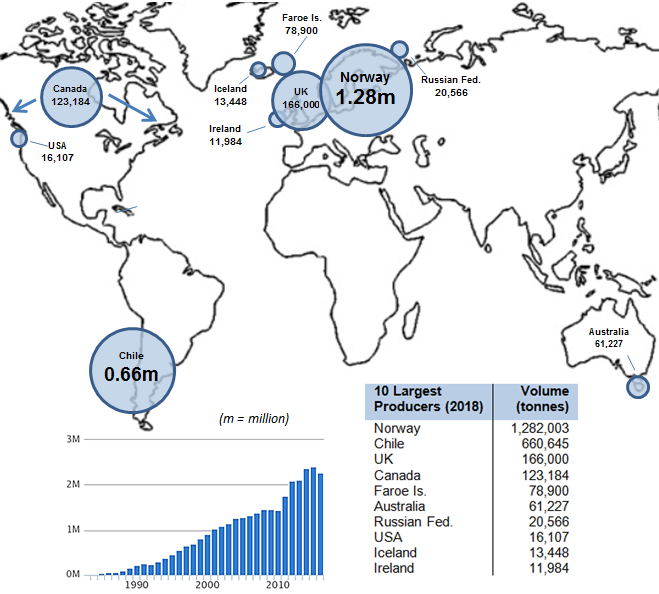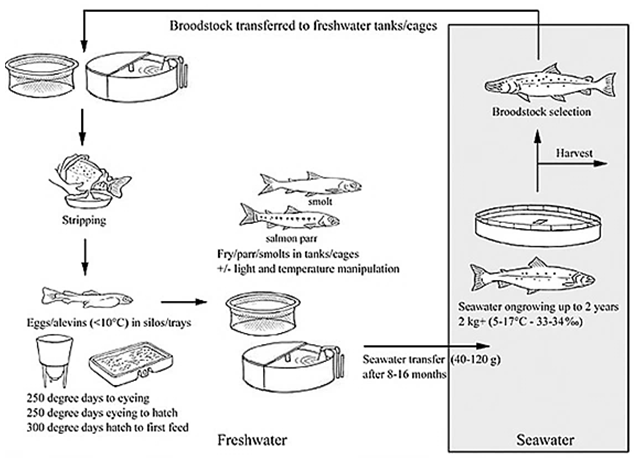Atlantic Salmon
Salmo salar
Sources, Quantities and Cultivation Methods
Sources and Quantities
Atlantic salmon (often known simply as ‘salmon’)1 is native to the North Atlantic and its islands (e.g. UK, Iceland, Greenland, etc.). Wild Atlantic salmon are anadromous; spending their adult life in the sea but swimming upriver to freshwater spawning grounds. After hatching, young salmon stay in rivers as parr for 1-5 years before undergoing physiological changes (smoltification) that enables them to migrate out to the open ocean. They head for deep water feeding grounds, and after 1-4 years the mature fish return to their home rivers to spawn2.
Wild populations of Atlantic salmon are generally at low levels and capture fisheries have seen significant decline2. Commercial fishing is now limited. Almost all commercially available Atlantic salmon is farmed and from locations with the necessary environmental and geographical characteristics (i.e. water temperature and coastlines with sheltered bays and inlets).
Apart from being farmed across its native range Atlantic salmon are also cultured as a non-native species along the coast of North America’s Pacific Northwest (i.e. British Columbia) and in countries such as Chile and Tasmania.
Atlantic salmon is one of the most important farmed finfish species in the world and its production is highly efficient. Global production has increased markedly since the early 1990's from around 30,510 tonnes in 1993 to over 2.43 million tonnes in 2018, valued at just over US$17 billion3.

As the map shows, Norwegian production is dominant and is over double that of its closest competitor, namely Chile. The UK (Scotland) and Canada are the other two major producers. These four countries represented some 91% of world Atlantic salmon production in 20183. During the last decade the salmon farming industry has seen a period of consolidation and production in each of the ‘big four’ is undertaken by five to ten companies4. Many of these companies are global enterprises with facilities in multiple countries.
Europe (including Russia) and North America are by far the largest markets for Atlantic salmon. However, emerging markets (such as Brazil and Asia) are growing at significantly higher rates than these traditional markets4. Farmed salmon is now Scotland’s largest food export by value and over 50 countries imported Scottish salmon in 2016, with the US and France being the largest markets5. Scottish salmon was the first fish and first non-French product to be awarded the Label Rouge quality mark6.
Domestic Market Information
Our domestic seafood market is complex mix of products from wild caught and farmed species. 'Salmon', has grown to dominate the seafood market in Great Britain (i.e. England, Scotland and Wales) in terms of both value and volume, the majority of which is farmed Atlantic salmon.
To discover more about the highly dynamic and ever-changing UK and Great British (GB) seafood marketplace, you can explore our user friendly and interactive Trade and Tariff in Tableau (T4) online tool. And visiting our dedicated Insight and Research pages will provide you with access to a wealth of information, from reports to factsheets on markets including:
- Retail – data from independent and multiple retailers in the UK used to reveal the latest insights on seafood eaten at home
- Foodservice – data from the foodservice industry in the UK used to highlight the latest trends on seafood eaten out of home
- Market supply – HM Revenue and Customs (HMRC) data used to detail what species and products are imported from, and exported to, the UK
To get the latest seafood market performance and trends delivered to your inbox, register at the Market Insight Portal.
Production Method
Atlantic salmon farming replicates the species natural cycle. It is divided in to two phases; freshwater - hatchery and smolt production, and seawater – growing the fish through until harvest4, 7, as shown in the production schematic below.

Selected adult broodstock are stripped of eggs and milt (sperm), and the eggs are fertilised. The first life stage or alevin have a yolk-sac and once absorbed they become free swimming fry and then develop further in to parr. These initial stages take place in freshwater tanks and the fry and parr are fed commercially available pelleted feeds tailored to their specific requirements. Parr develop further into smolts and at this stage they are ready to go to sea.
Traditionally in Scotland, parr are transferred to net-pens in freshwater lochs for further on-growing into smolts. Whilst this method is still important, industry is increasingly using sophisticated onshore recirculation systems which provide producers with greater control and faster growth rates; producing larger smolts and shortening the seawater grow-out phase8, 9.
Smolts can be transferred to the sea net-pens by several methods, including road, helicopter and well-boat. Once in the sea pens, the fish are fed a pelleted diet that is, again, tailored to their needs. The majority of Atlantic salmon are harvested after 14-20 months at sea, depending on the location10.
Fish are harvested at a size depending on the requirements of their destination market. Increasingly, the fish are transferred from the net-pens to a well-boat (a vessel with wells or tanks for the storage or transport of live fish) and transported to a shore-based harvest facility, where they are humanely stunned, bled and prepared for market. In Scotland a significant proportion of fish are now harvested directly into well-boats and 'dead hauled' to processing plants10.